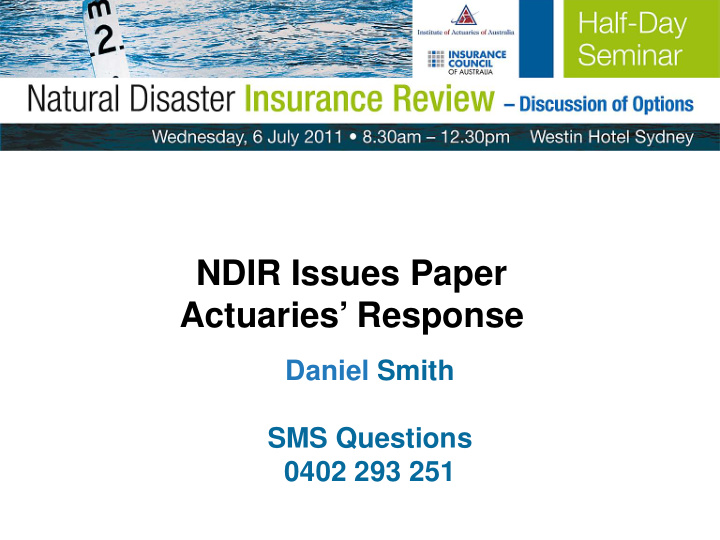



NDIR Issues Paper Actuaries’ Response Daniel Smith SMS Questions 0402 293 251
Actuaries Institute Working Group • e-mail calling for interested people • Around 30 people responded • 15 people have had active involvement • An Actuaries Institute work in progress – not a specific solution • Final submission due on the 14th
Structure of Response • Section 1 – Public Policy • Section 2 – Response to Issues Paper • Section 3 – Potential (alternative) models
Section 1 – Public Policy • Insurance, on its own, does not provide a sustainable long-term solution • Some properties are not economically sustainable (either due to their position or due to their construction/design) • A long term goal of risk management and mitigation is required (including relocation)
Section 1 – Public Policy (cont.) • Cross-subsidisation dulls the price signals that can drive desirable action • Government subsidies weaken the incentive for individuals (and councils etc.) to take risk mitigation actions • Intergenerational equity should be considered when assessing mitigation and funding options • Any funding solution should be transparent and should encourage effective risk management/mitigation
Section 1 – Public Policy (cont.) • An insurance solution does not address non- and under-insurance, predominantly low income individuals (across all natural perils, not just flood) • Individuals do not typically assess risk in the same manner as insurers (e.g. 1 in 100 year event) • Government has an important role to play in assisting individuals who cannot afford access to private insurance
Section 1 – Public Policy (cont.) • Contents, strata title and small business are important components which need a solution • Actions of the sea need to be addressed • National flood mapping is essential. Flood maps need to be widely accessible to all stakeholders
Section 2 – Response to Issues • There are pro’s and con’s to any solution. Issues are complex and there is not a perfect solution • In addition to accessibility and affordability we rec ommend the assessment of options include: – Mitigation incentives – Equity – Efficiency – Practical viability
Section 2 – Response to Issues (cont.) • The opt-out model does not remove post- inundation debate about whether the damage was caused by flood or storm etc. • Automatic flood cover poses numerous issues that need to be addressed – How will a structure ensure small and medium insurers can compete? – How can adverse selection be avoided without compulsion to insure? – Could lead to broader “red zoning” and reduced competition for non-flood perils – What will APRA’s response be?
Section 2 – Response to Issues (cont.) • We prefer the engineering threshold to the price threshold • The use of non-flood premiums as a basis for assessing relative flood risk may cause unintended distortions • The full economic cost of options needs to be considered, not just the short-term impact – would this make some “expensive” options more attractive?
Section 2 – Response to Issues (cont.) • Measuring flood risk is complex. Even with detailed flood maps there is considerable uncertainty • Development of suitable pricing for floods is not cheap. The costs could be prohibitive for some insurers relative to the size of the business • Consumers are often not well informed purchasers of insurance
Section 3 – Alternative Models • Market model with subsidies (health insurance) • Ratepayer funded model for water off the ground losses (central pool) • Natural disaster pool for declared events • Event threshold model (non-conditional above threshold and conditional below threshold) • Variable quota share flood pool • Compulsory national disaster insurance (base level cover for everyone, private insurance for top up)
Section 3 – Alternative Models (cont.) • All alternatives have strengths and weaknesses • Requires measurement against the assessment criteria • To some extent, the criteria have conflicting interests – some compromise required
Summary of Key Points • We do not consider that solving the flood insurance issue on its own provides an adequate long term solution • A long term solution needs to deliver risk mitigation and appropriate cost signals to discourage/prevent inappropriate future developments • We encourage the Review to consider whether a solution can be developed which improves the level of non- and under- insurance (across all natural perils, not just for flood cover) as well as the impact on low income individuals
Summary of Key Points (cont.) • We recommend that options be assessed against broader criteria: – Accessibility – Affordability – Equity – Efficiency – Mitigation incentives – Practical viability
Summary of Key Points (cont.) • We encourage the Review to include contents, strata title and SME’s where possible • We encourage the Review to consider the efficiency of the current system for dealing with funding of natural disasters • We encourage the Review to consider the impact of actions of the sea (particularly in light of projected rises in sea level)
Summary of Key Points (cont.) • We support Federal Government sponsored development of Australia-wide flood maps • We consider that flood maps should be made widely available to all stakeholders (and flood risk well communicated) • We note the importance of the structure of any pooling arrangement on the behaviours of the participants and puts forward a range of alternative structures
NDIR Issues Paper Actuaries’ Response Daniel Smith SMS Questions 0402 293 251
Recommend
More recommend